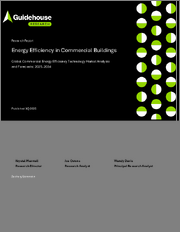
세계의 에너지 효율 기술 시장 규모는 2025년 1,737억 달러에서 2034년까지 2,655억 달러에 달할 것으로 예측되며, CAGR로 4.8%의 성장이 전망됩니다.
지난 10년간 상업용 건물에서는 에너지 절약 기술의 채택이 진행되어 왔습니다. 규제, 인센티브, 그리고 효율적인 기술에 따른 에너지 절약이 역사적으로 시장을 주도해 왔습니다. "지난 10년간 '스마트 빌딩'과 'IoT의 발전'은 이러한 기술을 향상시켜 왔으며, AI의 성장은 더 큰 기술적 촉진제가 될 가능성이 있습니다.
이러한 일관된 촉진요인에도 불구하고 에너지 절약 기술은 역사적으로 강력한 장벽에 직면해 왔습니다. 가장 효율적인 기술일수록 초기 투자비용이 가장 많이 드는 경우가 많습니다. 건물 소유주는 가장 효율적인 기술을 위해 집중적인 개보수보다 빠르고 간단한 솔루션을 선호하는 경우가 많기 때문에 시스템의 복잡성은 문제를 더욱 복잡하게 만듭니다. 상업용 빌딩 시장이 성숙해졌지만, 시장 리더들은 여전히 혁신을 계속하고 있으며, 기술은 더 효율적이고 비용 효율적이며 더 쉽게 도입할 수 있도록 계속 진화하고 있습니다.
세계의 에너지 효율 기술 시장에 대해 조사분석했으며, 시장 촉진요인과 장벽을 상세하게 검토하고, 향후 10년간 이 기술이 시장에 미치는 영향을 평가하고 있습니다.
Commercial buildings have increasingly adopted energy efficient technologies over the past decade. Regulations, incentives, and the energy savings associated with efficient technologies have historically driven the market. While "smart building" and "advances in IoT" have been improving these technologies over the past decade, the growth of AI has the potential to be a larger technical driver.
Despite these consistent drivers, energy efficient technologies have historically faced strong barriers. The technologies that are the most efficient often have the highest upfront investment costs. System complexity further compounds the issue, as building owners often prefer quick, simple solutions rather than undertaking intensive retrofits for the most efficient technologies. While the commercial building market is mature, market leaders are still innovating and the technology is still evolving to become more efficient, more cost effective, and easier to implement.
This report discusses these market drivers and barriers across various energy efficiency technologies in detail, evaluating their impact on the market for these technologies over the next 10 years. The market forecast estimates energy efficiency technology revenue from 2025-2034 across five global regions (North America, Europe, Asia-Pacific, Latin America, Middle East & Africa), five technology types (building energy management systems, heat pumps, HVAC controls, LEDs, lighting controls), and construction type (existing buildings, new construction). The market for energy efficiency technologies is expected to grow from US$173.7 billion in 2025 to US$265.5 billion in 2034, representing a compound annual growth rate (CAGR) of 4.8%.